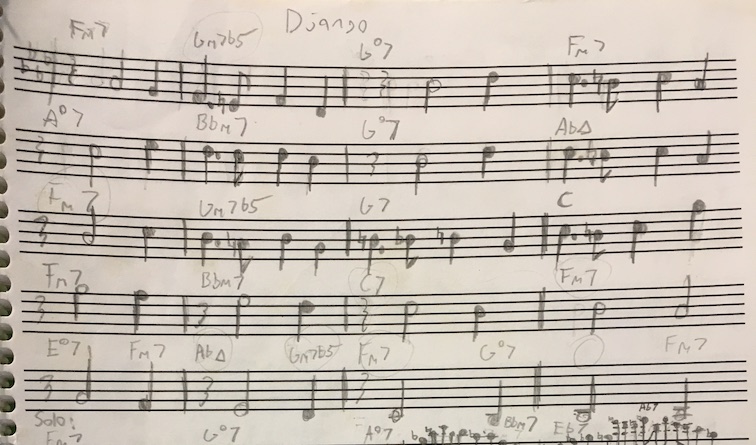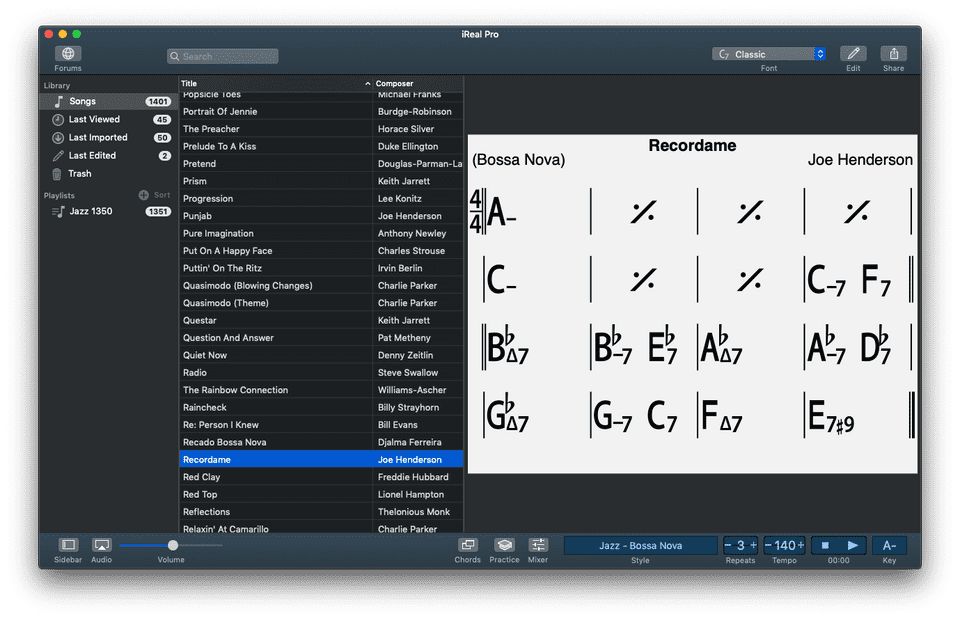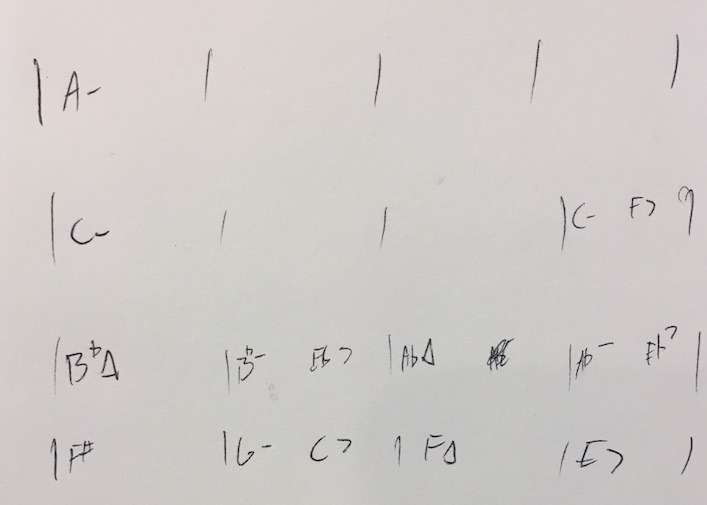Last night, I was watching this great LJS video on how to learn jazz tunes by ear. My thoughts went something along these lines:
“This technique would work great if I had an endless supply of simple, clear jazz recordings like the one in the video. But actual recordings are messy. The basslines and harmony are muffled, the tempos are faster, and the rhythms are more complex. Learning actual recordings is pretty much prohibitively difficult at my current skill level.”
I then realized how I could get an endless supply of simple, clear jazz recordings. In this post I’ll explain how, as well as a possible practice routine for getting better at learning jazz progressions by ear.
First, I’ll describe my experience with jazz ear training and explain why, despite its obvious importance, it’s been such an elusive practice subject for me.
An Anecdote
I’ve played jazz guitar for years. I took jazz guitar lessons throughout college, and I played with at least eight different combos in that time. I even took a semester of jazz bass lessons*. And it was only in my recent week at the excellent Jazz Port Townsend workshop that I finally confronted how shitty my jazz aural skills are.
Sure, I can recognize intervals, chord qualities, and scales. Not as well or as quickly as I’d like, but I definitely know how to do it. But in the many combo rehearsals and jam sessions, I realized how bad I am at recognizing harmonic movement.
Not only am I bad at it, I don’t even know how to do it. I can recognize basic ii-V-I progressions, sometimes, if the recording is high-quality and the chord voicings are simple. But beyond that it quickly becomes overwhelming to the point of guesswork.
 Chords I transcribed back in 2015 for the tune Django. They’re definitely super wrong.
Chords I transcribed back in 2015 for the tune Django. They’re definitely super wrong.
I realized that, not only did I have this glaring weakness, this weakness was pathological and affected my entire approach to jazz musicianship. Without the necessary aural skills, or the understanding of how to improve them, I had become a real book player and leadsheets were my crutch.
I could get by with this crutch (sort of) but it hindered my ability to learn tunes, to play what I hear, and to sit in at jam sessions.
I’m at a point now where I want that to change. I don’t want crutches, and I want to level up my musicianship. What’s the standard advice here?
*My semester of jazz bass was during my final semester of college, and I had a crippling case of senioritis preventing me from practicing.
The typical advice
In my experience, most musicians will say that to get better at learning chord progressions by ear, you just need to do it more. Play along with recordings on your instrument until you know the harmony. Do this enough, and you’ll recognize common harmonic devices and progressions.
This is all well and good, and I’m sure this is great advice for many musicians. But, like I mentioned, I actually don’t know how to learn tunes by ear. I make semi-educated guesses until I find the chord that seems to fit.
But I this guesswork is time-consuming and excruciating, and the benefits are questionable. Rather than becoming a better guesser, I’d like to not have to guess at all.
To this, most musicians will say to follow the bass line and learn to sing it. This too is good advice, and has helped me in many cases. But what to do when dealing with recordings where the bass line is muffled, walking quickly, or avoiding the root? In my experience, a majority of great jazz recordings have basslines that I can’t follow easily, causing me to fall back to frustrating guesswork.
Perhaps there are really two skills that I need to practice: hearing/singing bass lines, and using the bass line to intuit the harmonic movement.
Enter iReal Pro
iReal Pro is a great play-along app for jazz practice. It provides dynamic backing tracks for any number of jazz standards.
$20 is a fairly hefty price tag in the app world, but if you’re an aspiring jazz musician (especially who doesn’t regularly play with other musicians) then I think this is an invaluable practice tool.

The practice idea
I’ll finally cut to the chase here. My idea for working on my jazz harmony ear is quite simple:
- Download lots of song forms from the iReal Pro forum
- Export the track audio from iReal Pro, taking care to avoid looking at the chord charts
- Learn changes from the exported audio track and write my own chord charts
- When I’m 100% confident in my chart, I’ll finally compare it to the one in iReal Pro. This is really just a sanity check, since there should be no guesswork involved.
I’ll do this exercise with one or two tunes every day. In this way, I’ll improve my ear for bass lines and harmonic movement with clean and clear jazz recordings without the audio or tempo distractions mentioned at the beginning of this post. I view this more or less as training wheels that will let me really key in to the harmonic movement. As my ear improves, I’ll introduce actual jazz recordings to the mix. At that point, I’ll be better equipped to hear harmonic movement in real-world recordings.
An example
I ran through this exercise with Recorda-me last night. I simply couldn’t hear what the changes were in the original Joe Henderson track, and I found myself falling back to frustrating guesswork.
Compare that Joe Henderson track to the iReal Pro track:
Recorda-me by iReal Pro
Hearing the changes for the iReal Pro track is a much more manageable task for my current skill level. I was able to use this simplified track to figure out the chords without any guesswork:
 Recorda-me chord sheet, which I transcribed by ear without looking at the iReal Pro sheet.
Recorda-me chord sheet, which I transcribed by ear without looking at the iReal Pro sheet.
So I’m optimistic about this approach, and I look forward to seeing how I improve after a few weeks of daily practice. Of course, as with anything, a good practice itinerary is only part of the battle. The other part is discipline. Wish me luck!